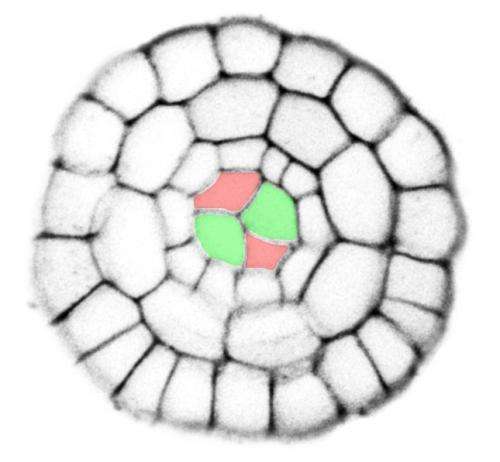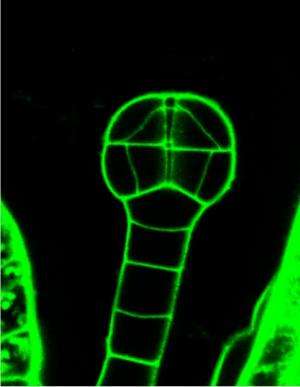How plants grow and develop

How does a complete plant with stems, leafs and flowers develop from a tiny clump of seemingly identical cells? For a very long time, the mechanism of tissue formation in plants remained unclear. The biochemists from Wageningen University also would not have come up with the answer if it wasn't for their model building colleagues that simulated plant development with their mathematical toolbox. They describe their joint discovery of the mechanism in the scientific journal Science of August 8.
Unlike animals, plants are not mobile and are anchored into the soil. Similarly, plant cells are also immobile. While early development of animals is characterised by cell migration, plant cells are tightly connected to each other. As a consequence, the plant embryo mainly grows through strictly oriented cell divisions in three dimensions. At the same time these groups of cells need to acquire specific 'identities' that will eventually lead to the formation of for example wood or vascular tissues. Up to now, it was completely unclear how these two crucial processes of growth and pattern formation were controlled during tissue formation in a way that the tissue remains stable despite continuous cell divisions. The researchers discovered that pattern formation of the vascular tissues already takes place when the embryo only contains four vascular precursor cells.
The research group of the Laboratory of Biochemistry of Wageningen University could show that a genetic network controls the orientation of cell divisions during vascular tissue development of the plant. This network switches on a set of genes that cause the production of the plant hormone cytokinin that, in its turn, regulates cell division and the orientation of those divisions. "But then we were stuck", explains researcher Bert De Rybel. "We could not think of an experiment to show that this genetic network simultaneously controls pattern formation." This is when the mathematical modellers of the Laboratory of Systems Biology came into the picture. "We wondered if those four initial cells are really identical." says Milad Adibi. "If those four vascular cells are identical, and complete symmetrical, like pieces of a pie, nothing would happen while simulating this."

Therefore, Bert De Rybel and coworkers re-examined the microscopical images they had taken. "To our surprise, our images of the four initial vascular cells showed that cells do not touch each other in one point. The two opposing cells share a small piece of cell wall. This way, they are distinct from the other pair of cells. We could even see this cellular connection on old recordings from 1995. Nobody had ever seen this, until the modellers pointed out that theoretically this connection must exist."
Plant hormones
The four-cell stage is therefore not a simple clump of identical cells. The secret of patterning is thus the combination of a common cell wall connection and a slight difference in concentration of the plant hormone auxin. The genetic circuit that was discovered by these researchers than makes sure the four cells further develop into a complete vascular tissue containing distinct cell types. The researchers could further show that local activity of this network, in those cells with higher auxin content, leads to divisions of the neighbouring cells and thus works as an organiser for the entire tissue. The same genetic network thus controls both growth through oriented cell divisions and pattern formation leading to distinct cell types.
"This is a model example of synergy, in which the combination of experimental biochemical and genetic research with theoretical mathematical models leads to novel insights than neither of the research groups could have accomplished by themselves!", according to prof. Dolf Weijers (Biochemistry) and Christian Fleck (Systems Biology).
More information: De Rybel B, Adibi M, Breda AS, Wendrich JR, Smit ME, Novák O, Yamaguchi N, Yoshida S, Van Isterdael G, Palovaara J, Nijsse B, Boekschoten M, Hooiveld G, Beeckman T, Wagner D, Ljung K, Fleck C, and Weijers D. (2014). Integration of growth and patterning during vascular tissue formation in Arabidopsis. Science, 8 August 2014.
Journal information: Science
Provided by Wageningen University




















